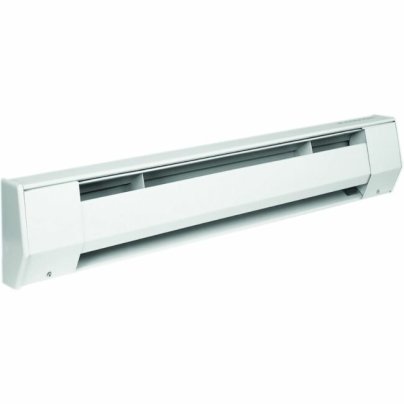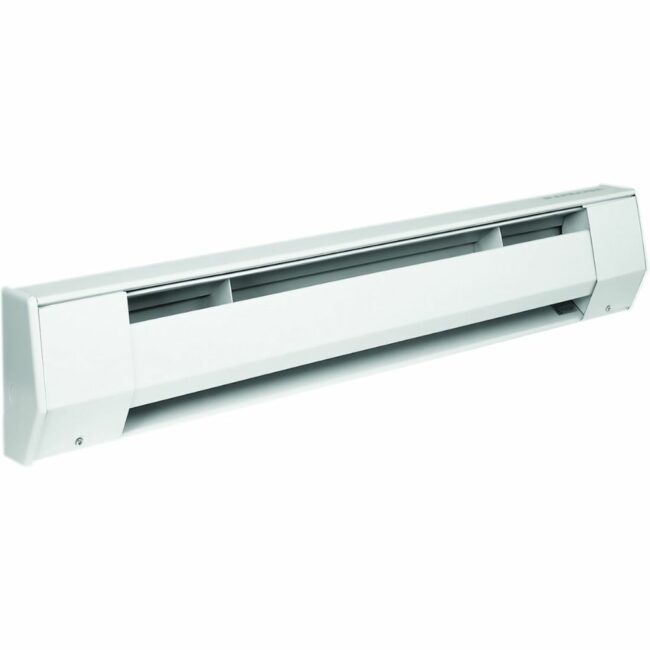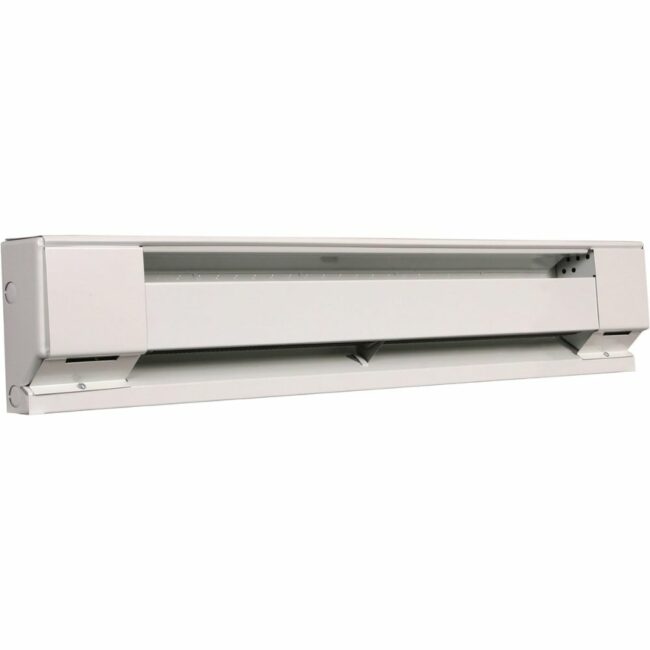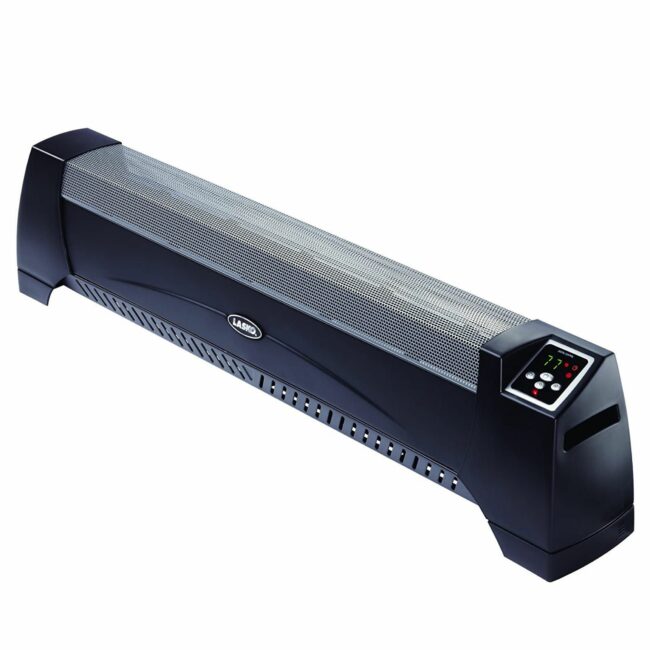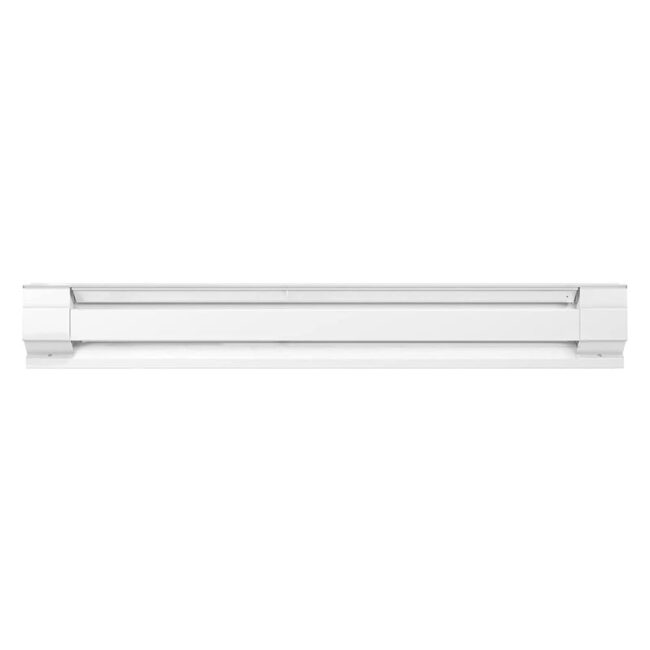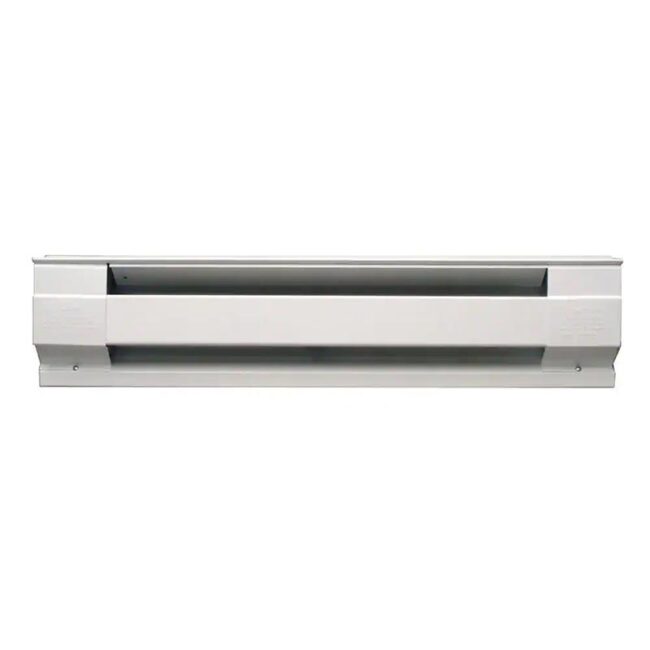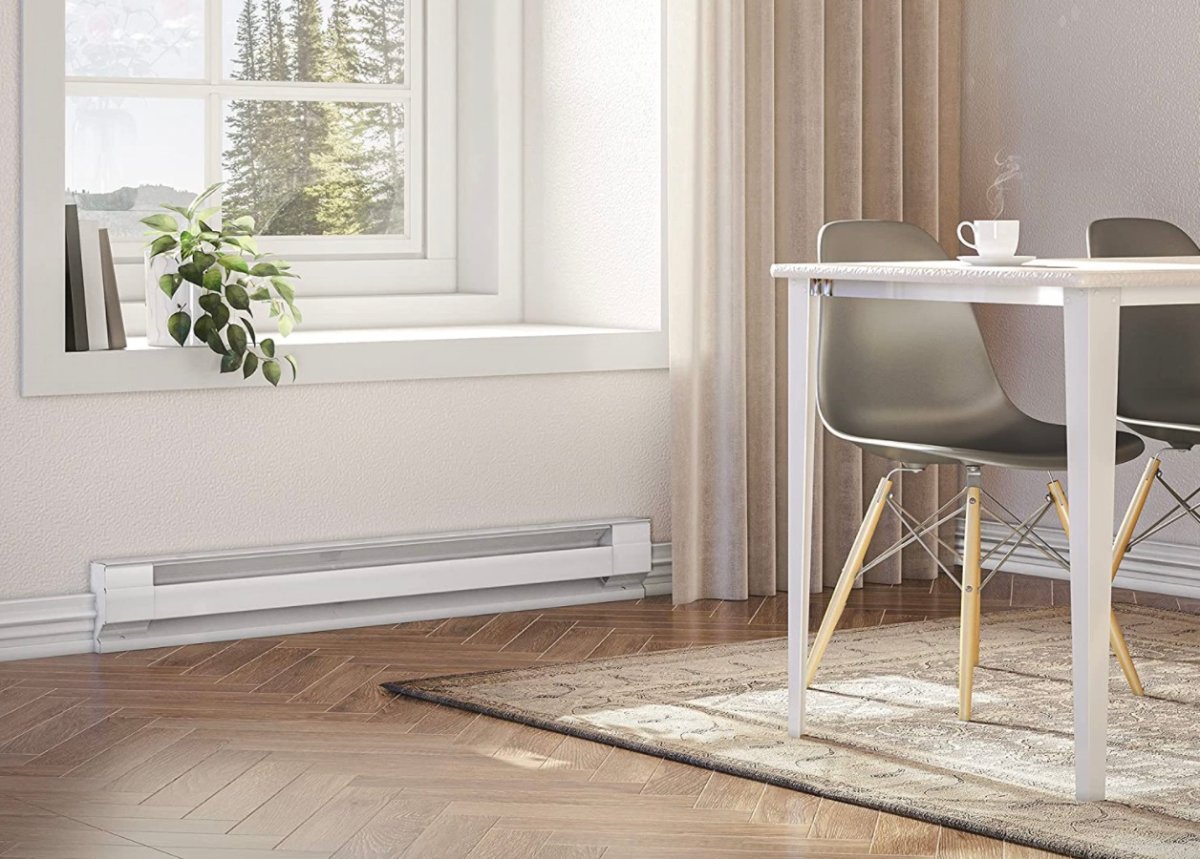
We may earn revenue from the products available on this page and participate in affiliate programs. Learn More ›
Many homes have that one room that just never gets as warm as the rest of the house—the one that’s either too far from the furnace to receive sufficient warm air or is lacking in insulation. Adjusting the dampers in the ductwork or redirecting warm air to the room by closing off vents may help, but these options typically aren’t sufficient to properly heat up a cold room.
A better solution is adding a baseboard heater to a home’s heating system to provide supplemental heat to a cold room or even heat the entire room on its own. Baseboard heating systems come in both electric models that radiate heat from metal fins and hydronic heaters that warm up liquid contained in a metal tube.
This guide examines these two different types of baseboard heaters as well as a host of other important features to consider when shopping for the best baseboard heater to warm a room.
- BEST OVERALL: King 6K2415BW K Series Baseboard Heater
- BEST BANG FOR THE BUCK: Marley 2542NW 240V 2-Foot Baseboard Heater
- BEST DESIGN: Lasko 5624 Low Profile Room Space Heater
- BEST FOR SMALL ROOMS: Cadet F Series 4-Foot Electric Baseboard Heater
- BEST FOR LARGE ROOMS: Cadet F Series 8-Foot Electric Baseboard Heater
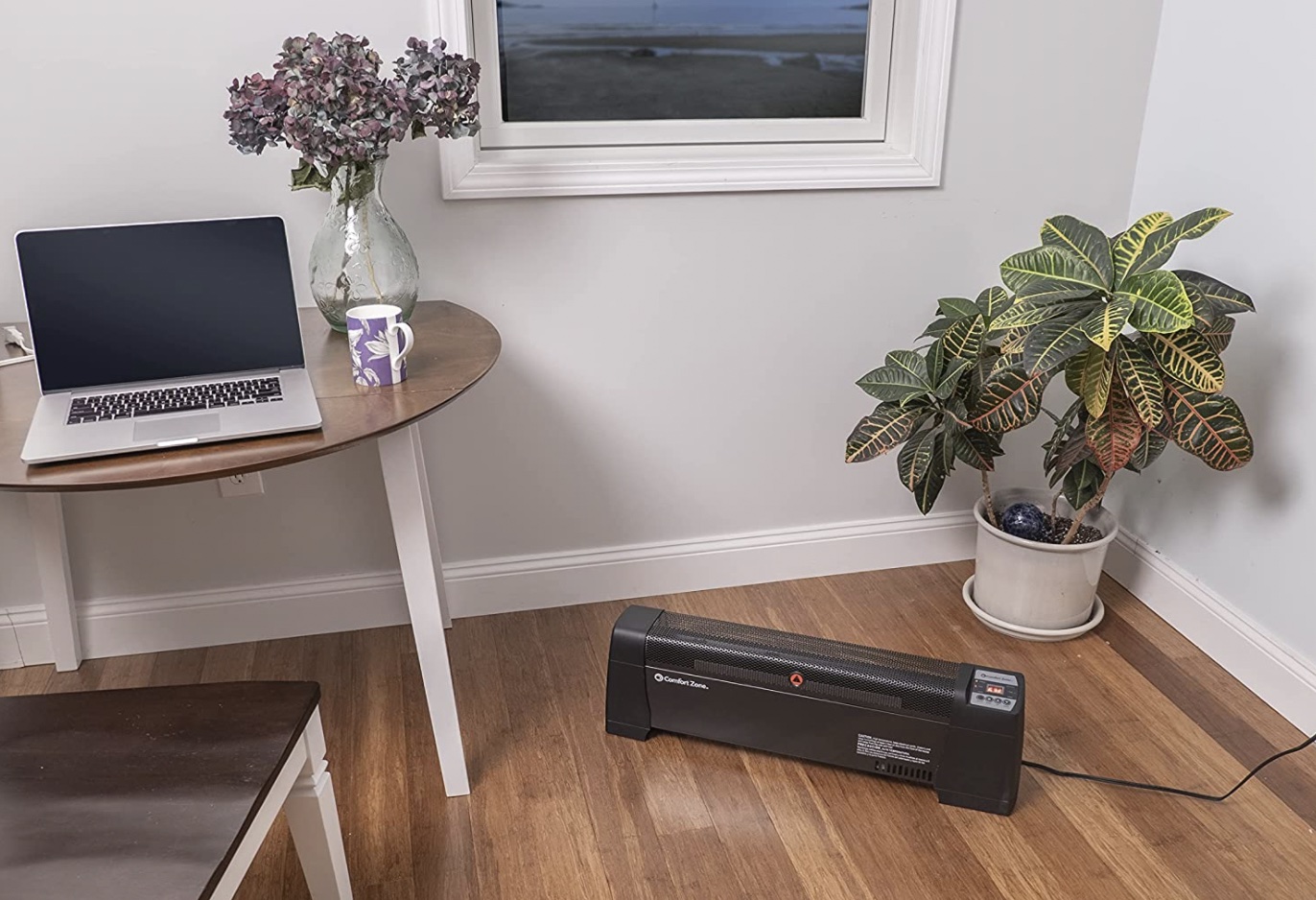
How We Chose the Best Baseboard Heaters
We collected our top picks for baseboard heaters in an effort to provide shoppers with options in terms of power, length, and type of heater. We made sure to offer both portable units as well as built-ins. We also included various lengths, from 30 inches all the way up to 8 feet, depending on the size of room requiring heat.
When gathering these recommended products, we made sure to consider only models from top manufacturers who use high-quality, durable materials, since baseboard heater units are known to take the occasional—and accidental—kick from nearby users.
Our Top Picks
The list below narrows the field to some of the top baseboard heaters on the market. We’ve featured various types of baseboard heaters with durable steel constructions, powerful heat outputs, and safety features that reduce the risk of fire.
Best Overall
King 6K2415BW K Series Baseboard Heater
See ItPros
- Made with a sturdy steel construction and a dent-resistant panel for long-term use
- Compatible with standard analog and WiFi-capable thermostats
- Comes in multiple colors to match a space’s current fixtures and decor
Cons
- May require a professional to install this model properly
Product Specs
- Type: Built-in
- Power: 1,125 to 1,500 watts
- Length: 72 inches
A simple design, inconspicuous appearance, and compatibility with a broad range of thermostats make this electric baseboard heater from King a worthy choice for adding supplemental heat to a room. This heater ranges from 1,125 to 1,500 watts of heat, and the wide vent runs along the top of the unit for effective distribution. With its sturdy steel construction, it can withstand bumps from shoes and vacuum cleaners without denting.
A sleek design and two color options—white and almond—help the heater blend nicely into most room designs. This baseboard heater also works with standard analog thermostats as well as higher-end WiFi-capable programmable thermostats. The King baseboard heater measures 6 feet long and requires a hardwired 240-volt connection.
Get the King baseboard heater at Amazon.
Best Bang For The Buck
Marley 2542NW 240V 2-Foot Baseboard Heater
See ItPros
- Steel and powder-coated construction is durable enough for long-term use
- Space-saving construction is suitable for rooms that need a slight heating boost
- Automatically shuts off when the unit begins to overheat for peace of mind
Cons
- Does not come with a thermostat; may need to be purchased separately
Product Specs
- Type: Built-in
- Power: 2,500 watts
- Length: 24 inches
This simple baseboard heater is a great option for providing supplemental heat to rooms that get short shrift from a home’s central heating system. At just 2 feet long, this heater takes up very little space, but it still pumps out 2,500 watts of heat, making it ideal for rooms that need a heating boost.
The heater is hardwired to a 240-volt power source and requires the separate purchase of a thermostat. With its steel construction and a powder-coated finish, this heater can endure abuse without denting or scratching. An overheat function automatically turns off the unit to prevent overheating if the air vents become blocked.
Get the Marley baseboard heater at Amazon.
Best Design
Lasko 5624 Low Profile Room Space Heater
See ItPros
- Sleek, low-profile design can be placed wherever additional heat is needed
- Digital thermostat controls are on the unit; no need to buy a separate thermostat
- Tip-over and overheat protection provide added peace of mind; suitable for homes with children and/or pets
- Built-in carry handles allow for portability or transporting if desired
Cons
- Not as long as other units currently on the market
Product Specs
- Type: Portable stand-alone
- Power: 1,500 watts
- Length: 39.75 inches
Most baseboard heaters require the user to purchase a compatible wall thermostat to control the unit, which adds to the overall expense, or settle for imprecise analog dial controls. This 1,500-watt heater from Lasko offers the best of both worlds, with digital controls on the heater that allow the user to set the built-in thermostat to a specific temperature by pressing a plus or minus button. It also includes a convenient timer that automatically shuts off the heater after one to eight hours.
With carrying handles molded into the sides, a length of just under 40 inches, and a weight of only 10 pounds, this space heater is designed to be moved easily from room to room. Safety features include a tip-over switch and overheat protection. This standalone unit uses a standard 120-volt plug for power.
Get the Lasko baseboard heater at Do It Best.
Best for Small Rooms
Cadet F Series 4-Foot Electric Baseboard Heater
See ItPros
- Low-profile design does not take up a lot of space once installed
- Sturdy steel construction is durable enough to withstand accidental kicks and bumps
- Quiet operation volume is suitable for bedrooms, nurseries, and offices
Cons
- Requires hardwiring and thermostat installation
Product Specs
- Type: Built-in
- Power: 750 or 1,000 watts
- Length: 48.3 inches
Providing supplemental heat for a smaller space doesn’t require a hefty 6-foot-long 1,500-watt heater. With its compact size and lower wattage output, this electric baseboard heater from Cadet is ideal for smaller rooms. At just 4 feet long, it’s ideal for mounting under a bedroom window. It produces a maximum of 1,000 watts of electric heating, enough to warm up to 100 square feet.
A simple streamlined design and white color allow it to blend in with a room’s decor, and the quiet operation volume should not cause any distraction. Steel construction makes it resistant to dents from accidental kicks or bumps from vacuum cleaners. Like many electric heaters, this model uses a 240-volt connection, so it must be hardwired and requires the purchase of a thermostat.
Get the Cadet 4-foot baseboard heater at Amazon or The Home Depot.
Best for Large Rooms
Cadet F Series 8-Foot Electric Baseboard Heater
See ItPros
- Durable steel construction and powder-coated finish resists dents and kicks; scratch- and chip-resistant design
- Includes noise-reducing nylon bushings; suitable for offices, bedrooms, and nurseries
- Great for larger rooms with its 8-foot design
Cons
- Required thermostat sold separately
- Must be hardwired; professional help will most likely be required
Product Specs
- Type: Built-in
- Power: 2,000 or 2,500 watts
- Length: 96 inches
At 8 feet long, this multi-watt baseboard heater from Cadet is well suited for distributing heat around larger rooms. Baseboard heaters are often susceptible to all manner of abuse from feet and other obstacles due to their position on the floor. With its 24-gauge-steel housing, this model is built to endure potential dents from shoes and vacuum cleaners. The metal housing has a powder-coated finish that resists scratches and chips to the paint.
Nylon bushings on the heater help eliminate noises as the heater warms and the metal expands. This heater must be hardwired to a 240-volt power source for 2,000/2,500 watts or a 208-volt power source for 1,500/1,875 watts. It also requires a thermostat (sold separately).
Get the Cadet 8-foot baseboard heater at The Home Depot.
Jump to Our Top Picks
What to Consider When Choosing a Baseboard Heater
The size and heat output of a baseboard heater are critical attributes to consider when shopping for a baseboard heater. Additional important features include thermostat type, integrated versus stand-alone, and ease of installation.
Power
Baseboard heaters use between 400 and 1,500 watts of power. The more power the heater uses, the greater amount of heat it can put out. Baseboard heaters require either a 240-volt or 120-volt connection for power. Units mounted to the wall are typically hardwired, while portable baseboard heaters have plugs that use a standard 12-volt outlet.
Room Size
A 1,500-watt heater is capable of heating a small basement, bedroom, or office of up to 150 square feet, equivalent to a 10- by 15-foot room with 8-foot ceilings. Less powerful models are sufficient for supplementing the heat in a room that is generated by a central furnace. While a 1,500-watt heater is capable of heating a small room all by itself, keep in mind that using an electric baseboard heater as a sole source of heat is much more expensive than using a central heating system.
Electric or Hydronic
Electric baseboard heaters heat up metal fins that warm air in the room as it passes through the heater, whereas a hydronic baseboard heater heats up fluid in an enclosed pipe that runs through the heater.
Electric baseboard heaters heat up fast but cool very quickly once the thermostat switches off. Hydronic heaters are more efficient because the heated fluid they use to radiate heat retains its warmth longer than metal fins. This means they continue to deliver heat even after the thermostat clicks off, making hydronic baseboard heaters more energy-efficient than electric models. However, since it takes time to heat up the liquid in the tube, hydronic baseboard heaters take longer to warm up than electric models.
Integrated or Stand-Alone
Integrated baseboard heaters mount to the wall of a room, becoming permanent fixtures. They are typically located under windows where they can warm cool air that falls from the window above and recirculate it throughout the room. Integrated baseboard heaters are typically hardwired, so they usually require a professional electrician for installation.
Stand-alone heaters have feet that allow them to stand upright with no wall mounting or installation required. They typically use 120-volt plugs and are lightweight enough to allow the user to move them from room to room.
Built-in Thermostat
Integrated baseboard heaters usually require the user to purchase a thermostat controller to go with the unit, which increases the overall cost. Some electric baseboard heaters have an analog dial on the unit that allows the user to set a temperature from level 1 to 10. This can make setting the baseboard heater to the desired temperature a bit of a mystery. Higher-end baseboard heaters connect to wall-mounted thermostats that allow the user to set the thermostat to an actual temperature.
Installation
Installing a hardwired baseboard heater requires the user to understand voltage, circuits, and even local electric codes. The installation process involves adding a new circuit to the home’s circuit panel and routing power to the location of the baseboard heater. Installation also requires specialized tools, such as a voltage meter.
Failing to properly wire a baseboard heater could create a fire hazard or a risk of electric shock. With all these factors in mind, it’s best to hire a licensed electrician to install a hardwired electric baseboard heater. When considering the expense of a baseboard heater, keep in mind the cost of installation. Electrician labor rates range between $50 and $100 an hour depending on the market, according to HomeAdvisor.
Stand-alone units require no installation, as they use a standard 120-volt plug and outlet for power.
Maintenance
Maintaining a baseboard heater is a necessary part of making sure it works efficiently and safely. Most units have steel covers that help protect the vulnerable metal fins or metal tubing that distributes heat from the unit. Since baseboard heaters are located near the floor, over time they are inundated with dust and dirt. Most models have removable covers that allow the user to access these heating elements and clean them with a vacuum cleaner brush attachment.
Safety
Baseboard heaters have built-in safety mechanisms to prevent them from overheating and creating a fire hazard. All baseboard heaters have a safety switch that automatically shuts the unit off if the vents are blocked, which could cause the unit to overheat. Stand-alone units have tip-over safeties that shut the unit off in the event it topples over, as well as an automatic shutoff if the unit begins overheating. Baseboard heaters also have metal housings that create a buffer to prevent people and objects from coming into contact with the heating element.
FAQs
If you have questions about how efficient baseboard heaters are or what size heater to purchase for your home, read on for answers.
The general rule of thumb for sizing an electric baseboard heater is to have 10 watts of electric heating for every square foot in a room. Using that equation, a 100-square-foot room should have a heater using at least 1,000 watts to adequately heat it. Keep in mind that a baseboard heater can be significantly smaller if it’s supplementing a room that is already heated by a central furnace.
Since all-electric baseboard heaters convert 100 percent of the electricity they use into heat, purchasing a newer baseboard heater won’t make it more efficient than an older one.
While baseboard heaters are 100 percent efficient at turning electricity into heat, that doesn’t mean baseboard heaters are energy-efficient sources of heat, as the power plants generating the electricity they use are typically inefficient.
In fact, an electric baseboard heater can cost as much as four times more than a standard gas furnace to heat an entire home, according to the U.S. Energy Information Administration.
It depends on the wattage of the baseboard heater. Most baseboard heaters use 1,500 watts, which is large enough to heat a 150-square-foot space.
A baseboard heater typically needs about a foot of clearance from furniture to avoid creating a fire hazard. In general, nothing should restrict the flow of hot air around a baseboard heater to prevent it from overheating.
